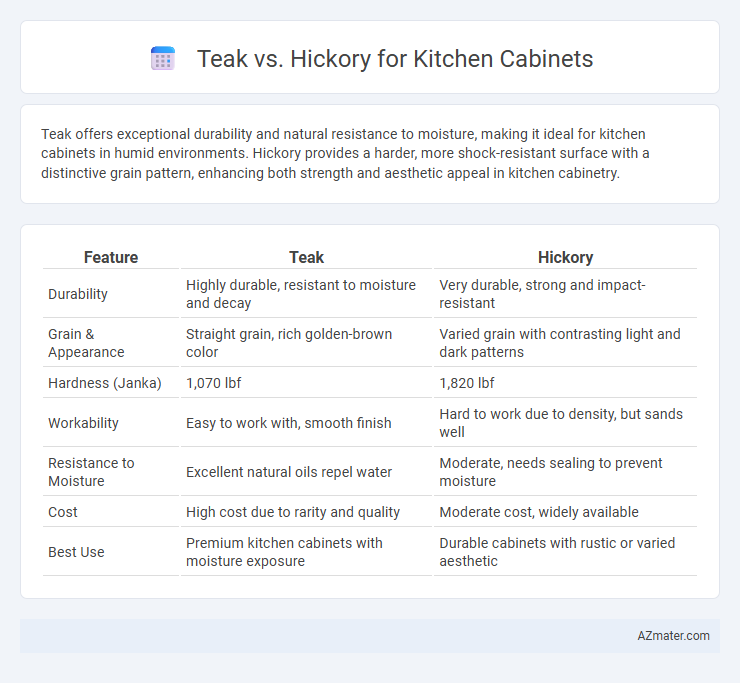Teak offers exceptional durability and natural resistance to moisture, making it ideal for kitchen cabinets in humid environments. Hickory provides a harder, more shock-resistant surface with a distinctive grain pattern, enhancing both strength and aesthetic appeal in kitchen cabinetry.
Table of Comparison
| Feature | Teak | Hickory |
|---|---|---|
| Durability | Highly durable, resistant to moisture and decay | Very durable, strong and impact-resistant |
| Grain & Appearance | Straight grain, rich golden-brown color | Varied grain with contrasting light and dark patterns |
| Hardness (Janka) | 1,070 lbf | 1,820 lbf |
| Workability | Easy to work with, smooth finish | Hard to work due to density, but sands well |
| Resistance to Moisture | Excellent natural oils repel water | Moderate, needs sealing to prevent moisture |
| Cost | High cost due to rarity and quality | Moderate cost, widely available |
| Best Use | Premium kitchen cabinets with moisture exposure | Durable cabinets with rustic or varied aesthetic |
Overview of Teak and Hickory Woods
Teak wood features a dense grain and natural oils, making it highly resistant to moisture, decay, and insects, ideal for durable kitchen cabinets. Hickory wood offers exceptional hardness and striking color variations, providing robust strength and a rustic aesthetic in cabinetry. Both woods excel in durability, with teak favoring moisture resistance and hickory standing out for impact resilience in kitchen environments.
Key Differences in Appearance
Teak kitchen cabinets showcase a warm, golden-brown hue with a smooth, straight grain that adds a sleek, modern look to any kitchen space. Hickory cabinets feature a more rustic and varied appearance, characterized by strong grain patterns and contrasting knots that highlight its natural charm. The visual appeal of teak leans towards uniform elegance, while hickory emphasizes texture and organic visual interest.
Durability and Hardness Comparison
Teak offers exceptional durability for kitchen cabinets due to its natural oils that resist moisture, decay, and insect damage, ensuring long-lasting performance in humid kitchen environments. Hickory is one of the hardest domestic hardwoods, known for its high Janka hardness rating of about 1,820, making it extremely resistant to dents and scratches. While teak's hardness rating is slightly lower, around 1,070 on the Janka scale, its superior resistance to water damage often makes it a preferred choice for durable kitchen cabinetry in areas prone to humidity.
Maintenance Requirements
Teak kitchen cabinets offer exceptional durability and require minimal maintenance due to their natural oils that resist moisture, insects, and decay. Hickory cabinets, while sturdy and dense, need regular sealing and periodic refinishing to protect against scratches and moisture damage. Choosing teak reduces long-term upkeep efforts, whereas hickory demands more frequent care to maintain its appearance and structural integrity.
Cost Analysis: Teak vs Hickory
Teak kitchen cabinets typically cost between $150 to $200 per square foot due to their durability and natural resistance to moisture, making them a premium choice. Hickory cabinets generally range from $100 to $140 per square foot, offering a more affordable yet strong and dense hardwood option with distinct grain patterns. Choosing between teak and hickory largely depends on budget constraints and desired longevity for kitchen cabinetry.
Suitability for Kitchen Environments
Teak offers exceptional moisture resistance and natural oils that protect against humidity, making it ideal for kitchen cabinets exposed to steam and spills. Hickory is extremely durable and impact-resistant but requires proper sealing to prevent moisture damage in kitchen environments. Both woods provide strength, yet teak's inherent water repellency makes it more suitable for long-lasting kitchen cabinetry in humid conditions.
Environmental Impact and Sustainability
Teak wood, sourced primarily from Southeast Asia, is prized for its durability but often raises sustainability concerns due to deforestation and slow growth rates in natural forests. Hickory, native to North America, generally offers a more eco-friendly choice because of its faster growth and availability from well-managed forests promoting responsible harvesting practices. Choosing certified teak (FSC or PEFC) or reclaimed wood alternatives can mitigate environmental impact, while hickory provides a robust option with a lower carbon footprint and better potential for sustainable sourcing.
Design Flexibility and Style Options
Teak offers rich golden hues and a smooth grain that lends itself well to contemporary and tropical kitchen cabinet designs, providing high design flexibility for warm, inviting spaces. Hickory, with its distinctive knots and varied grain patterns, brings a rustic, farmhouse aesthetic and allows for bold, textured style options suited to traditional and country kitchens. Both woods support diverse finishes and stains, enabling customization to match sleek modern or classic cabinetry styles.
Pros and Cons of Teak Cabinets
Teak kitchen cabinets offer exceptional durability and natural resistance to moisture, making them ideal for humid kitchen environments, while their rich golden-brown color adds warmth and elegance to any design. However, teak tends to be more expensive than other hardwoods like hickory and requires regular oiling to maintain its luster and prevent drying out. Compared to hickory's rustic and highly textured appearance, teak provides a smoother, more uniform grain, but it may lack the bold character preferred in country or farmhouse kitchen styles.
Pros and Cons of Hickory Cabinets
Hickory kitchen cabinets offer exceptional durability and a striking grain pattern, making them a popular choice for rustic or traditional kitchens. The wood's hardness ensures resistance to dents and scratches, but its natural color variation may require careful matching to maintain a consistent aesthetic. While hickory is cost-effective compared to exotic woods like teak, it may darken over time and needs regular maintenance to preserve its appearance.

Infographic: Teak vs Hickory for Kitchen Cabinet
 azmater.com
azmater.com